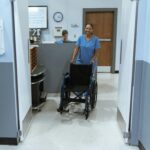American Job Centers (AJCs) are a key component of the public workforce system. They provide a critical set of resources to jobseekers looking for employment or career growth. ORR-eligible populations often qualify as a priority service population in Workforce Innovation and Opportunity Act (WIOA) programs. Individuals enrolled in these programs may be able to access individualized career navigation services, free or subsidized job training, apprenticeship or on-the-job opportunities, and supportive services. For more information about AJCs, eligibility requirements, and services, check out the Department of Labor’s Workforce Investment page and this Switchboard post about how resettlement agencies can benefit from working with their local AJC.
What is Co-location?
Co-location means an American Job Center (AJC) shares space with other community-based service providers to increase access for marginalized jobseeker populations and strengthen the opportunity to collaborate.
ORR service providers work alongside AJC staff and share expertise, resources, and a mutual commitment to the career goals and self-sufficiency of refugee and immigrant families. There are many different models and approaches to co-location. Below, we highlight a successful approach from Snohomish County, Washington.
Promising Practice: Co-location in Snohomish
At Workforce Snohomish, Refugee and Immigrant Services Northwest (RISNW) relies on co-located service delivery to provide robust employment services to eligible refugee and immigrant populations through the local AJC.
Two RISNW staff are co-located at Workforce Snohomish sites full time. They are tasked with providing culturally competent, language-accessible services to refugee adults, including intake and eligibility screening, WIOA enrollment, skills screening, career navigation, connection to subsidized or free job training opportunities, and job placement services. A third staff member splits time between RISNW and Workforce Snohomish and works alongside AJC colleagues on the SnoCo Futures project to help youth ages 16–24 overcome barriers to obtaining a high school diploma or GED, as well as begin their engagement with the world of work.
Benefits of the RISNW Co-location Model
Co-located Staff Can Address Refugee Barriers to Services
ORR-eligible populations who qualify for WIOA services may struggle with the eligibility screening and enrollment processes, especially if they are English language learners or have documents that are less commonly recognized by AJC staff. At Workforce Snohomish, co-located RISNW staff speak nine languages, and they can easily connect with their RISNW colleagues for additional on-call interpreters who speak 137 languages. As a result, refugee residents of Snohomish can better understand their opportunities, advocate for the services that best meet their needs, and more readily pursue their skills training and career goals.
RISNW staff are well positioned to help refugees access and organize the many pieces of identity, income, and work authorization documentation required to enroll in WIOA services. Co-located staff can also support AJC colleagues who might be unfamiliar with refugee identity and work authorization documents, further building AJC’s capacity to serve these community members.
Benefits to ORR Populations
Refugees and other ORR-eligible immigrants benefit from co-located staff at Workforce Snohomish in multiple ways. In the short term, the presence of RISNW staff at the AJC allows ORR populations the opportunity to access otherwise untapped funds for occupational skills training and additional supportive services.
In the future, refugees who understand the public workforce system in Snohomish can return to their AJC for additional career navigation services in accordance with their professional development goals. Refugees who are equipped with information about the robust set of employment services at Workforce Snohomish can also more easily refer eligible friends, family, and other members of newcomer populations to ensure better utilization of this community resource.
Benefits to ORR Service Providers
Like many ORR service providers, employment staff at RISNW are often tasked with ensuring rapid client self-sufficiency. The pace of this work may require that they focus on initial job placement as opposed to longer-term skill building and career planning.
Co-located refugee-serving staff at Workforce Snohomish have the potential to draw on the capacity and resources of the AJC career navigation teams to provide additional support to these individuals as they consider their skills and career goals. In some cases, co-located staff can also draw on the AJC’s funds for occupational skills training and supportive services. This close collaboration with the AJC may relieve stress and pressure from ORR employment service providers by opening the door to more and longer-term resources, and it may help providers achieve self-sufficiency and other outcome goals for their client populations.
Benefits to AJC
The Department of Labor provides funding for Workforce Snohomish contingent on its ability to enroll and serve eligible youth, adult, and dislocated workers. Co-location allows AJCs to better target and provide services to key priority populations, a topic that DOL has recently released additional guidance and benchmarks on. Additionally, regular interaction with immigrants and immigrant-serving staff gives the AJC insight into its limits and gaps in its services. It also highlights opportunities to advocate for structural or administrative changes that would better support diverse community members in securing and thriving at in-demand jobs throughout their region.
Next Steps
Service providers interested in co-location of their staff at an AJC or vice versa should contact their local AJC program administrators. The RISNW/Workforce Snohomish model is one among many, so refugee-serving staff should be prepared to think through the kinds of collaborations that would best serve their refugee clients, carefully considering the following factors:
- The accessibility to refugees of the AJC vs. ORR service provider location
- Service and funding gaps the ORR service provider and AJC most readily encounter in working with this population
- The availability of desk space at the AJC vs. ORR service provider
- Which entity has the budget to support co-located staff, or which new funding opportunities might be able to support co-located staff










